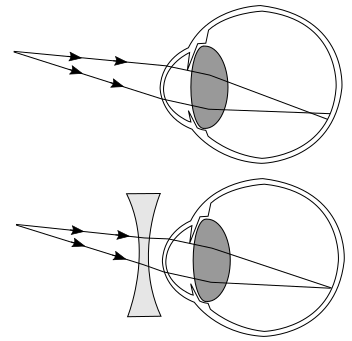
What is myopia? How to correct it?
Answer
499.5k+ views
Hint: Myopia is a type of eye defect in which a person can see objects close to him/her clearly, however, the objects farther away are seen blurry. This defect is also known as nearsightedness.
This can be corrected by using a concave (diverging) lens that is placed before a myopic eye, moving the image back to the retina, and making it clearer.
Complete step by step answer:
Myopia (Nearsightedness) is a type of eye defect in which a person can see objects close to him/her clearly, however, the objects farther away are seen blurry. It occurs because the shape of the myopic eye lens becomes such that it refracts the light rays in front of the retina instead of focusing them on the retina.
This problem is most common in the young generation. This defect mainly occurs due to the irregularity in the shape of the cornea. If the curvature of the cornea becomes more than the normal curvature, it will not be able to refract all the light rays coming from a distant object on the retina. As the light rays meet in front of the retina, the light-detecting nerve cells, present at the surface of the retina, will not be able to focus the image correctly. Therefore these nerve cells detect a blurry image of the distant object.
Since the myopic eye converges light rays more than the normal, the correction for myopia is to place a diverging lens or concave (curved inwards) lens in front of the eye. This reduces the power of an eye that is too large.
The correction is shown in the figure:
The first image is of the myopic eye. The two rays intersect and form an image in front of the retina.
In the second picture, this defect is corrected after placing the concave lens in front of the eye which forms an image exactly at the retina.

Note:
Nearsightedness may develop gradually or rapidly, often occurring during childhood and adolescence. It tends to occur genetically.
A basic eye test can confirm myopia. You can reduce the blur with spectacles, contact lenses, or refractive surgery.
This can be corrected by using a concave (diverging) lens that is placed before a myopic eye, moving the image back to the retina, and making it clearer.
Complete step by step answer:
Myopia (Nearsightedness) is a type of eye defect in which a person can see objects close to him/her clearly, however, the objects farther away are seen blurry. It occurs because the shape of the myopic eye lens becomes such that it refracts the light rays in front of the retina instead of focusing them on the retina.
This problem is most common in the young generation. This defect mainly occurs due to the irregularity in the shape of the cornea. If the curvature of the cornea becomes more than the normal curvature, it will not be able to refract all the light rays coming from a distant object on the retina. As the light rays meet in front of the retina, the light-detecting nerve cells, present at the surface of the retina, will not be able to focus the image correctly. Therefore these nerve cells detect a blurry image of the distant object.
Since the myopic eye converges light rays more than the normal, the correction for myopia is to place a diverging lens or concave (curved inwards) lens in front of the eye. This reduces the power of an eye that is too large.
The correction is shown in the figure:
The first image is of the myopic eye. The two rays intersect and form an image in front of the retina.
In the second picture, this defect is corrected after placing the concave lens in front of the eye which forms an image exactly at the retina.

Note:
Nearsightedness may develop gradually or rapidly, often occurring during childhood and adolescence. It tends to occur genetically.
A basic eye test can confirm myopia. You can reduce the blur with spectacles, contact lenses, or refractive surgery.
Recently Updated Pages
Master Class 11 Economics: Engaging Questions & Answers for Success

Master Class 11 Business Studies: Engaging Questions & Answers for Success

Master Class 11 Accountancy: Engaging Questions & Answers for Success

Questions & Answers - Ask your doubts

Master Class 11 Accountancy: Engaging Questions & Answers for Success

Master Class 11 Science: Engaging Questions & Answers for Success

Trending doubts
A boat goes 24 km upstream and 28 km downstream in class 10 maths CBSE

Why is there a time difference of about 5 hours between class 10 social science CBSE

The Equation xxx + 2 is Satisfied when x is Equal to Class 10 Maths

What is the full form of POSCO class 10 social science CBSE

Change the following sentences into negative and interrogative class 10 english CBSE

Discuss the main reasons for poverty in India




